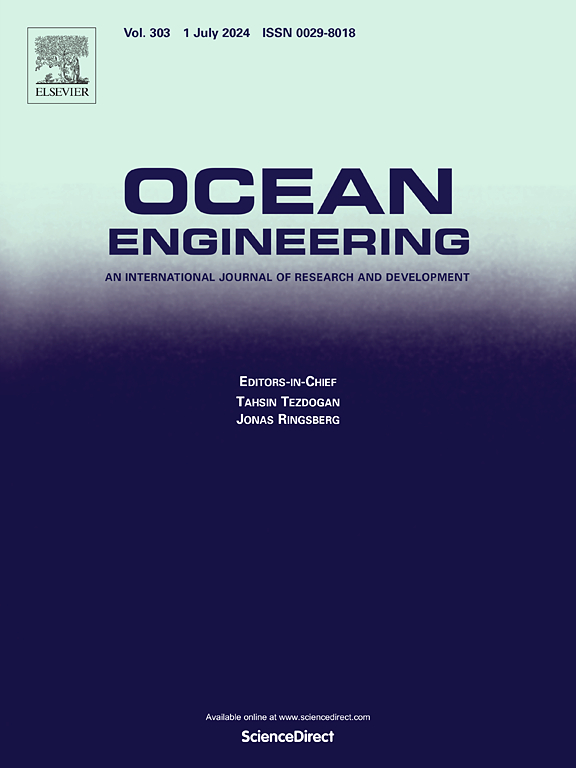游鱼在半气缸尾流区的水动力性能
IF 5.5
2区 工程技术
Q1 ENGINEERING, CIVIL
引用次数: 0
摘要
环境涡流的特征对鱼类的行为策略有很大影响。本研究通过对不同尺度半圆筒的流体动力学效应进行数值量化,研究了障碍物产生的尾流涡如何影响鱼类行为的推进力和稳定性干扰。半圆筒再循环区域的强反向流在尾部附近产生了尾缘涡流,这降低了推力,并在尾流涡流撞击时诱发了不稳定性。减小半圆筒与鱼体之间的间隙会延长中断的持续时间。此外,当涡流之间的间隙较小时,通过的尾流涡流会对鱼尾产生阻力,并破坏鱼的稳定性。值得注意的是,对于位于小型半圆筒后面的鱼类来说,尾流涡流撞击并不会造成阻力和不稳定;相反,阻力的主要来源是脱落的尾流涡流。这些因素将扰动区域从半圆筒的边缘横向扩展到尾流区域外直径的两倍。只有再循环流以外的下游区域才能提供有益的低动量湍流环境。这项研究的发现可能会加深人们对涡流与鱼类相互作用的理解,并为生物启发式水下航行器的设计和路径规划提供有价值的见解。本文章由计算机程序翻译,如有差异,请以英文原文为准。
Hydrodynamic performance of swimming fish in the wake region of a semi-cylinder
The characteristics of environmental vortices significantly influence the behavioral strategies of fish. This study investigated how wake vortices from obstacles affected propulsion and stability disturbances in fish behavior by numerically quantifying hydrodynamic effects related to different scales of semi-cylinders. The strong reverse flow in the recirculation regions of semi-cylinders generated trailing edge vortices near the tail, which reduced thrust and induced instability upon wake vortex impingement. Decreasing the gap between the semi-cylinder and the fish increased the duration of disruption. Additionally, passing wake vortices induced drag on fish tails and destabilized the fish when the gap between the vortices was small. Notably, for fish behind small semi-cylinders, wake vortex impingement did not cause drag and instability; rather, the primary source of drag was the shed wake vortices. These factors extended the disruption region laterally from the edges of the semi-cylinder to twice its diameter outside the wake region. Only the far downstream area, beyond the recirculation flow, could provide a beneficial turbulence environment with low-momentum flow. The findings of this study may enhance the understanding of vortex-fish interactions and offer valuable insights for the design and path planning of bio-inspired underwater vehicles.
求助全文
通过发布文献求助,成功后即可免费获取论文全文。
去求助
来源期刊

Ocean Engineering
工程技术-工程:大洋
CiteScore
7.30
自引率
34.00%
发文量
2379
审稿时长
8.1 months
期刊介绍:
Ocean Engineering provides a medium for the publication of original research and development work in the field of ocean engineering. Ocean Engineering seeks papers in the following topics.
 求助内容:
求助内容: 应助结果提醒方式:
应助结果提醒方式:


